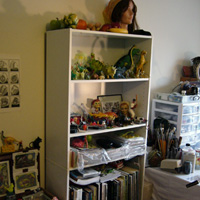
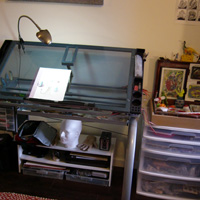
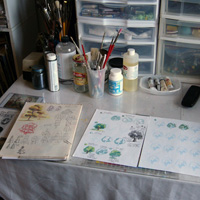
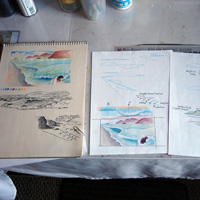
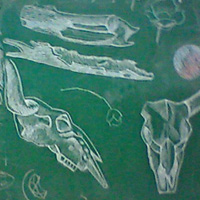
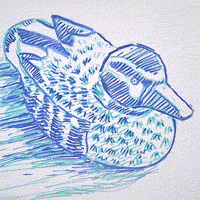
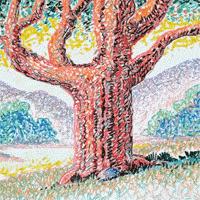
Index:
1) Intrusive Thinking and Creativity
2) The Role of Missing Information in Creativity
3) Art and Algorithms
4) Art, A.I., and Culture
5) Autism and The World
6) YouTube Channel and Miscellaneous
Studio Photographs and Notes: Here are a few photographs of my work environment. Notes for my Inventing Landscapes with Color Pencil class, which was offered through Ivy Tech Community College, are seen on my work table. Due to the development of Fuchs dystrophy, a corneal eye disease which will eventually require surgery, I have given up my drawing classes, but not yet my painting classes.
The last series of photographs are from classroom settings for drawing classes before 2021, where I regularly executed drawings for instruction. The first image contains chalk drawings, and later the use of dry erase markers, as seen in the last two images. I have drawn countless drawings over the years for classes, and because I did own a smart phone at the time, I had no practical camera for recording them. I can only compare my drawings to Buddhist sand paintings, but someone other than myself erases them.
Modernist Aesthetic: I admittedly credit myself with an immodest degree of uniqueness, which stems from my formative exposure to and adaptation of Modernism in art school. As a creature of this Twentieth Century aesthetic, I spent a portion of my formative youth rebelling against the ruinous tyranny Modernism became through art academia in the 1980s. By the time we get to Post-Modernism, and its glib politics used to justify the lamest banality imaginable, those distant European pioneers, who inspired me to apply my imagination first and foremost, were long dead and relegated to the pages of art survey books.
Modernism is ended in its best sense, and what we are left with are self-aware parodies of its once revolutionary ideas (as found in anachronistic, factory-showroom Manhattan galleries). Today we live in an era of post-ism-ism, where everything is allowed. There are many more crafty artists than in times past, especially where artists accomplish unparalleled levels of achievement by furthering styles originated in other epochs. This unprecedented commitment to doing-one-better has given us a kind of replicable scientific algorithm.
Imagination and Its Enemies: In this current age, three ways of thinking about making art dominate: abstract, figurative, and figurative-abstract. As someone who have dabbled in the first two, abstract art is harder to make than you realize, and figurative is easier to make than you realize. Neither approach requires much imagination as an ingredient since the inherent structure of the art is nine tenths of the final product. Yes—some imagination is required to make tweaks to the formula, but the body of work in all three approaches is so well established that proficiency alone becomes the measure of achievement. Therefore, the lowest common denominator among proficients becomes the prevailing style.
Art movements become victims of their own success, since more artists are able to meet the proficiency test. Unless you got in on the ground floor for one of the varient offshoots in style or subject matter, then (to put it bluntly) you are merely a copyist of someone else’s hussle.
While there may be many cooks in the kitchen, only one of several broths are available for finetuning, so what is required to succeed begins to look more like ability than imagination. Historically, imagination becomes less valuable over time due to its scarcity. This makes it easy to marginalize imagination, or damn it with faint praise.
2024 and The Death of Culture: As of 2024, one see a massive die-off across every creative industry, from films to gaming to the arts. A range of YouTube channels will describe this decline variously, from the shoehorn insertion of DEI (diveristy, equity, and inclusion) agendas into creatively diminished products, to the greed of large media conglomerates buying up aging intellectual properties and doing them to death.
Younger generations of consumers have no great affection for their grandparents’ culture, so do not support Ghostbuster 12, or whatever repackaged bleached bones Hollywood is still trying sell. Thoughtless greed of this sort destroyed the music industry when an artist’s past catalog became a form of crypto currency. New music was no longer needed—or so it was thought.
I do not know if culture can recover on this blighted landscape, and though artificial intelligence can breath new life into some corners, it is, like everyone else, repackaging other people’s stuff.
In my case, it is the greatest challenge imaginable to get anyone to watch any of my YouTube videos featuring original art, music, comics, and fiction.
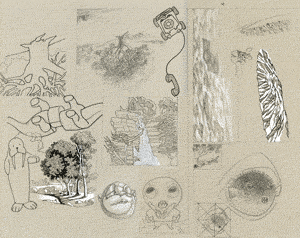 A typical page of sketch ideas for art projects.
A typical page of sketch ideas for art projects.
Part Thinking and Autism Part-Thinking is one of the hallmarks of autism. Obsession over details in how something is put together becomes the means by which the thing is reverse engineered. This novel back-to-front approach allows one to forge an original perspective on reassemblage.
Surrealism, as it was originally conceived, would reframe the “problems” that arise in stream-of-consciousness creation as “engineering opportunites.” Although my operation as a painter may be described as part-to-part, it is not entirely random. I have learned from past mistakes. Every painting I create begins as a painting within a painting. And growing out of my comicbook background, such partitions are used as bulkheads, or safety walls, to impose a semblance of order on my creative process. This way the central ideas do not conflict with each other, or awkwardly overlap, or clutter up the composition unproductively. The partition architecture of comics, as I evolved, gave me a way to set ideas in juxtaposition to one another that did not require explanation. The structure nevertheless suggests connecting tissues and back channels of communication that are not, at first, apparent.
I do not like having to start at zero more than once in a painting or drawing. On average, there are two to three big ideas per work of art, which are first envisioned in simple outline.
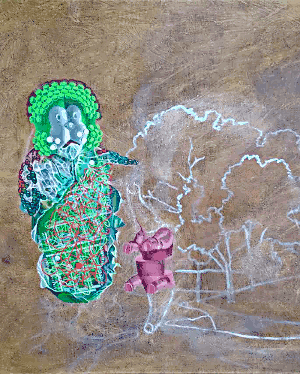 My painting process for this project has been documented through time-lapse photography, which has been released in a series of three videos on my YouTube channel, Autism and The Arts. The first one is a discussion of my creative thinking, while the last two document my completion of the project.
My painting process for this project has been documented through time-lapse photography, which has been released in a series of three videos on my YouTube channel, Autism and The Arts. The first one is a discussion of my creative thinking, while the last two document my completion of the project.
I pursue each section within a painting or drawing from start to finish (usually) before starting the next section. Each main idea gets further subdivided into smaller, denser bits; and as these develop, I need to reevaluate how the rest of the painting is likely to react to this new information, and make adjustments accordingly. Creative spontaneity is preserved since the terrain over which the new idea is introduced is compartmentalized. This does not prevent the new idea from migrating to other parts of the project, or inspiring other ideas. But in each instance, it is a small move before becoming a larger move.
Collage as Intrusion: By collage, I mean to artificially or superficially manipulate a drawing or painting that already exists in broad outline. The point of this manipulation is to introduce a catalyst whose effects cannot be predicted. This catalyst enters through a side door, away from the principle action, which makes its sudden appearance ambiguous but material.
Within my paintings during the 1990s, I cut up pieces of failed paintings and glued or sewed them into newer works. This was not my intention when I made the first painting, obviously. And yet, the collage element carried its history with it, which got co-opted by the later work. (See the last page of my Art School Portfolio Pages for examples of this.)
Collage Technique in Creative Writing: This cut-and-paste creative license did not fully mature until I began to write my first novel in the early 2000s.
The computer, as a seamless editing tool, allowed me to splice together ideas continuously as experimentations. Over a ten year period, my online novel changed frequently as scenes were added and subtracted. With each manipulation of information, I needed to go back through the entire book and adjust other scenes to accommodate the new information: that is, with regard to what a character knew, and when he or she knew it. Even where these reworked scenes were later removed, the effects they left behind were, in many instances, left in place as improvements. In a few instances, extraneous features of this type were never explained.
As was often the case, the replacement was less explanation than the original idea; and so my novel, as it progressed toward its end, became more by being less. By the end, finalizing my novel was a subtractive process.
Collage Thinking in Comics: My creative life largely revolved around making art for my comicbooks from the late 1980s through the late 1990s. Comicbook storyboards became less linear in their storytelling as things went along until, eventually, I gave up on both linearity and storytelling within the full page format. Late comicbook comics, which may be seen within the comics portal from my home page, came to resemble stream of consciousness collections of splash pages.
Once I began my comic strip Blender Kitty around 1999, this became the vehicle through which I developed storytelling ideas. From there, my comicbook work ceased. My stand-alone drawings expanded into this void and became “fine art” entities in their own right alongside my paintings. Though my storyboard format lost its original purpose, it nevertheless remains behind in my drawing style as a relic of the 1990s. It may be found in many finished drawings seen within my Current Artwork portal. (See second gallery page.)
Une Semaine De Bonté: Surrealist Max Ernst’s collage novel, Une Semaine De Bonté is a masterpiece of absurd juxtaposition. In it, he cut and pasted together Victorian lithographic illustrations to create original surreal images. He then supplied text, which itself may have been derived by a similar splicing operation of unrelated words and phrases. A synergy emerged from this strange juxtaposition of irrational text and irrational images which could not be derived from either component individually.* This is a triumph of associative thinking.
(*I talk about Ernst’s influence on my early painting process late in my Portfolio pages.)
Association versus Randomness: Champions of artificial intelligence may not have, to date, considered this unmeasurable parameter of association. I am sure that they would dismiss this associative idea as being a feat easily achieved: If Max Ernst can cut up words and images and toss them in different hats, then a computer is capable of producing these random generators, as well.
Were it only random, then I would allow that A. I. might occasionally do better than Ernst, by accident.
The surrealists, for all their celebration of accident, nudged outcomes in desirable directions. The pairing of random bits were weighted; and not all pairings were of equal weight. Intuition was the apothecary to the final decision, not randomeness.
This selection bias may be compared to a photographer who shoots a hundred pictures on a given day. He keeps six and throws out the rest. This selection is not decided by computation, but by the life experience of the creator, whose emotions may bring to his mind myriad memories that, as much as anything, infuses his eclectic decisions with personal value. This is the beginning of his unique style.
In emerging artificial intelligence art generator jargon, this nudging is called “guiding,” where a prompter injects himself into the latent space of A. I. assemblage. A. I. may be able to join random ideas, but the value in this coupling must be assigned by a third party. Two unrelated visual ideas may be funny because of unanticipated wordplay between them. Or this thing looks like this other thing upside down, but with a mustache. Etcetera… A thousand possible assoiciation might be listed, and they might not even be the right thousand. Associations may jump across media and disciplines. They may owe their existence to chance, a plan gone awry, or a bad ham sandwich.
When I was diagnosed with Aspergers in 2007, I was given an I. Q. test. Although I was verbally gifted, my performance score was left wanting. While my therapist and I looked over the spreadsheet on the table, I could only think that my intelligence originated from a bare part of the table not covered by paper. At the time, I was thinking of creative intelligence, but the term associative intelligence aptly describes what I meant.
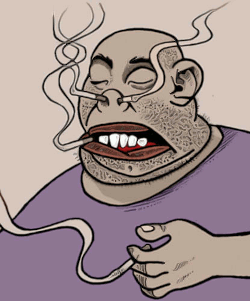
Other Forms of Intrusive Thinking: Intrusive thinking can take many forms. The best example I can provide is the Flatland Analogy:
A two-dimensional creature would perceive a three-dimensional sphere passing through its plane of existence as first being a point that magically appears in space. As slices of the sphere pass through its plane, the point expands to become a circle, which then shrinks again to become a point before vanishing. One may describe collage similarly, in whatever form it takes where it intersects one idea with another. This intrusion may be temporary, but its permutations have lasting consequences on both the architecture and psyche of what remains behind.
The McGuffin: Alfred Hitchcock developed the concept of the McGuffin, which is an object within a movie that serves as a trigger device for the plot. For example, someone places a bomb in a briefcase, and then places the briefcase under a table before other characters enter the room; the anxious movie viewer knows more than does the characters.
In order to turn this idea into an intrusive idea, the bomb in the briefcase does not go off, and is never mentioned again. The bomb remains armed and, much like a spur unseen under a saddle, is felt by the viewer who remembers it.
The Hidden Play Within a Play: Another intrusive technique is to hide one part of your story from its other parts. The novel, The King in Yellow, by Robert W. Chambers, makes use of this device by referring to a cursed play within the book that is never itself presented. (The title of my new novel refers to a forgotten movie script that was never realized as a movie.)
Uncanny Spaces and David Lynch: Movie director David Lynch is a master in the art of misdirection. His intention is to confound the movie goer’s expectation by introducing liminal spaces and omitting explanatory information.
Early in Inland Empire, a dramatic conservation is interrupted by ominous goings-on in another part of a large empty film studio. The dark building abruptly resembles a haunted house. The protagonist is carried away from the conversation before its important message is fully revealed. This gives rise to unsettledness.*
In Lynch’s short film, Rabbits, actors dress as rabbits and interact through non sequiturs over a laugh track. Occasionally an ominous presence comes to the door, but we never discover who or what is on the other side this barrier.
I was so inspired by Rabbits that I wrote an outline for a short story that involved blind moles and the disruption that comes to their world by way of a periodic and intrusive lawn mower. I have since lost this text, or perhaps never committed it to a digital document. However, elements of this story were cannibalized for early notes to my second novel. These ideas were later omitted. The only surviving vestige of this venture was the use of a lawnmower man in my html video, Stare At The Love. (This video may be seen through my YouTube channel.)
(*Norwegian conceptual artist, Børre Sœthre, explores these types of imposed-upon relationships in his close-environment art installations.)
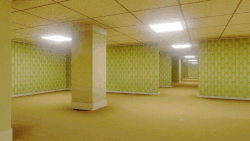 The Backrooms.
The Backrooms.
Liminal Spaces and Epigenetic Wiring: The Backrooms began as an Internet phenomenon growing out of the analog horror tradition, which seeks to recreate VHS media of the 1990s. (I discuss analog horror as a concurrent cultural development to my early animations in 2008. These notes are found in my animation portal and on my third sketchbook page.)
The allure of the backrooms as urban legend lies in the unwholesomeness of its piss-colored walls and buzzing fluorescent lights, both of which evoke an eroded VHS tape aesthetic.
From my perspective as someone who lived through the 1990s as a grown adult, the backrooms is a variation on office cubicle torture chambers, where office workers were forced to spend eight hour days watching drop ceilings discolor and sag from leaky air conditioner condensation. I did not work in a cubicle. Nor did I work an eight hour day. Regardless, I had a job that required me staying in one place for long periods of time. It was not pleasant, and there was no escaping the sensory overload of so much non-being. Any given instance of reality may be described as tragic where there is no creative outlet to transform it.
Aging VHS media makes lost worlds seem creepier than they actually were. This compares to how we see old photographs of turn-of-the-century mental asylums as haunted houses. When I look at black and white photographs of myself from the early 1960s, such as one where I pose in my Sunday-best clothes for Easter church services, I am struck by its deterioration. My Easter picture resembles an aged daguerreotype of a Civil War field hospital.
To be in that place at that time, without a VHS or daguerreotype overlay to color it, was neither liminal nor eerie. Liminal space is a recent construction. It did not exist until Gen-Yers started ghost hunting and urbexing in old buildings. One may see these explorations as a natural marriage of past and present through recycled resources, which is a predictable outcome for an Internet starved for new content.
Loss of context is gradual, but it gets punctuated every so often. The lens through which we view our nondescript world yellows, and then it becomes someone else’s creepy photograph found in an attic. Perhaps what millennials experience when they look at yellow office spaces is akin to epigenetic wiring:
Where one’s ancestors atrophied in these poisonous environments, somehow these memories get absorbed by offspring, who have no firsthand experience of these spaces apart from a positive fear of them.
Copyright © 2023-2022 michael l. teague all rights reserved.